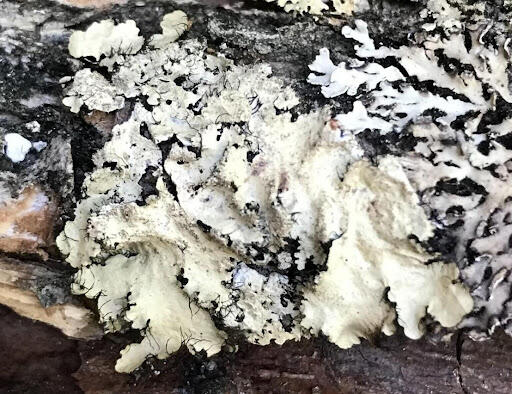







Loading profile. Please wait . . .
Parmotrema haitiense (Hale) Hale
Haitian Ruffle




Federal Protection: No US federal protection
State Protection: No Georgia state protection
Global Rank: GNR
State Rank: SNR
Element Locations Tracked in Biotics: No
SWAP 2015 Species of Greatest Conservation Need (SGCN): No
SWAP 2025 Species of Greatest Conservation Need (SGCN): No
2025 SGCN Priority Tier: None
Element Occurrences (EOs) in Georgia: 0
Habitat Summary for element in Georgia: Upland woodland, mesic forest
Gray-green thallus of 0.5-1-cm-wide lobes, surface glossy & faintly maculate; undersides brown, black in center, with short rhizines to lobe edges (interspersed with longer ones); old lobes with abundant laminal isidia, short, becoming branched & occasionally ciliate; lobes with abundant, black cilia at edges; CHEMISTRY: medulla K-, KC+ pink to red, C-, PD-, UV- (norlobaridone); FIELD ID: if familiar with this complex, a field K test on the medulla will sort out this species
Parmotrema neotropicum & P. subtinctorium are similar but their medullae react K+ blood red (see key below)
None
Upland woodland, mesic forest, on hardwood bark: Liquidambar, Ulmus
Corticolous foliose lichenized fungus, photobiont a green alga (Trebouxia?)
None
Coastal Plain
Unknown
Rare
None
Brodo, I. M. 2001. Lichens of North America. Yale University Press, New Haven, Conn.
Esslinger, T. L. 2021. A cumulative checklist for the lichen-forming, lichenicolous and allied fungi of the continental United States and Canada. Version 24. Opuscula Philolichenum 20: 100-394.
Harris, R. C. & D. Ladd. 2005. Preliminary draft: Ozark lichens. Unpublished manuscript, New York Botanical Garden, Bronx, NY.
Malcolm Hodges
25 May 2022